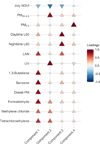Environmental Exposures and Anti-Müllerian Hormone: A Mixture Analysis in the Nurses' Health Study II
- PMID: 36455251
- PMCID: PMC9720700
- DOI: 10.1097/EDE.0000000000001547
Environmental Exposures and Anti-Müllerian Hormone: A Mixture Analysis in the Nurses' Health Study II
Abstract
Background: Previous studies have linked environmental exposures with anti-Müllerian hormone (AMH), a marker of ovarian reserve. However, associations with multiple environment factors has to our knowledge not been addressed.
Methods: We included a total of 2,447 premenopausal women in the Nurses' Health Study II (NHSII) who provided blood samples during 1996-1999. We selected environmental exposures linked previously with reproductive outcomes that had measurement data available in NHSII, including greenness, particulate matter, noise, outdoor light at night, ultraviolet radiation, and six hazardous air pollutants (1,3-butadiene, benzene, diesel particulate matter, formaldehyde, methylene chloride, and tetrachloroethylene). For these, we calculated cumulative averages from enrollment (1989) to blood draw and estimated associations with AMH in adjusted single-exposure models, principal component analysis (PCA), and hierarchical Bayesian kernel machine regression (BKMR).
Results: Single-exposure models showed negative associations of AMH with benzene (percentage reduction in AMH per interquartile range [IQR] increase = 5.5%, 95% confidence interval [CI] = 1.0, 9.8) and formaldehyde (6.1%, 95% CI = 1.6, 10). PCA identified four major exposure patterns but only one with high exposure to air pollutants and light at night was associated with lower AMH. Hierarchical BKMR pointed to benzene, formaldehyde, and greenness and suggested an inverse joint association with AMH (percentage reduction comparing all exposures at the 75th percentile to median = 8.2%, 95% CI = 0.7, 15.1). Observed associations were mainly among women above age 40.
Conclusions: We found exposure to benzene and formaldehyde to be consistently associated with lower AMH levels. The associations among older women are consistent with the hypothesis that environmental exposures accelerate reproductive aging.
Copyright © 2022 Wolters Kluwer Health, Inc. All rights reserved.
Conflict of interest statement
The authors report no conflicts of interest.
Figures




Similar articles
-
Investigating the Consequences of Measurement Error of Gradually More Sophisticated Long-Term Personal Exposure Models in Assessing Health Effects: The London Study (MELONS).Res Rep Health Eff Inst. 2025 May;2025(227):1-78. Res Rep Health Eff Inst. 2025. PMID: 40682491 Free PMC article.
-
Particulate Air Pollutants, Brain Structure, and Neurocognitive Disorders in Older Women.Res Rep Health Eff Inst. 2017 Oct;2017(193):1-65. Res Rep Health Eff Inst. 2017. PMID: 31898881 Free PMC article.
-
Air pollution and anti-Müllerian hormone: the Doetinchem Cohort Study.Environ Int. 2025 Jul;201:109565. doi: 10.1016/j.envint.2025.109565. Epub 2025 May 28. Environ Int. 2025. PMID: 40472756
-
Individualised gonadotropin dose selection using markers of ovarian reserve for women undergoing in vitro fertilisation plus intracytoplasmic sperm injection (IVF/ICSI).Cochrane Database Syst Rev. 2018 Feb 1;2(2):CD012693. doi: 10.1002/14651858.CD012693.pub2. Cochrane Database Syst Rev. 2018. Update in: Cochrane Database Syst Rev. 2024 Jan 4;1:CD012693. doi: 10.1002/14651858.CD012693.pub3. PMID: 29388198 Free PMC article. Updated.
-
Drugs for preventing postoperative nausea and vomiting in adults after general anaesthesia: a network meta-analysis.Cochrane Database Syst Rev. 2020 Oct 19;10(10):CD012859. doi: 10.1002/14651858.CD012859.pub2. Cochrane Database Syst Rev. 2020. PMID: 33075160 Free PMC article.
Cited by
-
Neighborhood Vulnerability and Age of Natural Menopause and Menopausal Symptoms Among Midlife Women.JAMA Netw Open. 2025 May 1;8(5):e2512075. doi: 10.1001/jamanetworkopen.2025.12075. JAMA Netw Open. 2025. PMID: 40402495 Free PMC article.
-
Air pollution exposure in vitrified oocyte donors and male recipient partners in relation to fertilization and embryo quality.Environ Int. 2024 Nov;193:109147. doi: 10.1016/j.envint.2024.109147. Epub 2024 Nov 13. Environ Int. 2024. PMID: 39547088 Free PMC article.
-
Air pollutants and ovarian reserve: a systematic review of the evidence.Front Public Health. 2024 Sep 23;12:1425876. doi: 10.3389/fpubh.2024.1425876. eCollection 2024. Front Public Health. 2024. PMID: 39376999 Free PMC article.
-
Laparoscopically confirmed endometriosis and anti-Müllerian hormone levels: Findings from the Nurses' Health Study II.Maturitas. 2024 May;183:107969. doi: 10.1016/j.maturitas.2024.107969. Epub 2024 Mar 14. Maturitas. 2024. PMID: 38489917 Free PMC article.
-
Ambient traffic related air pollution in relation to ovarian reserve and oocyte quality in young, healthy oocyte donors.Environ Int. 2024 Jan;183:108382. doi: 10.1016/j.envint.2023.108382. Epub 2023 Dec 12. Environ Int. 2024. PMID: 38103346 Free PMC article.
References
-
- Duncan FE, Confino R, Pavone ME. Female Reproductive Aging. In: Conn’s Handbook of Models for Human Aging. Elsevier; 2018:109–130. doi:10.1016/B978-0-12-811353-0.00009-9 - DOI

